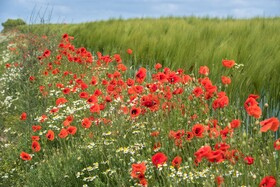


This goal was achieved, but with high externalities:
This goal has not been achieved. The current design of the CAP primarily serves to secure the income of large farms, as approximately 300 euros in direct payments are distributed per hectare of land. Many smaller farms, on the other hand, are forced to abandon their farms because they can no longer cover their costs. Farmers also receive less and less money for their products on the market, and their negotiating position in the supply chain vis-à-vis downstream processing and trade is weakened due to the dismantling of market regulations in the EU.
Technical progress has been achieved, but the input:output ratio has not improved and in some cases has even deteriorated: for every kilojoule of input, the farmer today sometimes generates only one kilojoule of output. By comparison, at the beginning of the 19th century, the input:output ratio was 1 to 7 and higher. The goal of safeguarding nature and the environment has not been achieved either.
Thus, the EU's self-imposed goals will not be achieved with the current agricultural policy and the one planned for the coming funding period. This is also serious because agriculture can directly or indirectly influence a large part of the 17 goals of the Sustainable Development Goals (SDGs). Thus, it has an impact on the following goals:
However, the current design of the CAP thwarts these goals. The strong focus of funding on area payments promotes intensive production and does not constitute a targeted instrument for maintaining farm structures: 1.7 percent of all farms in Germany receive a quarter of the direct payments, while 1.6 percent of farms in the EU receive 30 percent of the money. So there is plenty of money, but only a few benefit from it. In particular, farms that farm in an animal-friendly and environmentally friendly manner are not supported, because direct payments under the first pillar currently account for about 40 percent of farms' income. In order to generate sufficient income, farmers must therefore have a sufficiently large farm size - only then will subsidies be paid to a sufficient extent. A large number of hectares therefore also means income security. The result: small farms stop and large ones grow; profit is currently generated mainly by large landowners and food traders.
The current draft of the Common Agricultural Policy for the years 2021 to 2027 does not change this structure either. Large sums continue to flow into direct payments with an additional focus on technical innovations. It is foreseeable that mainly large farms will continue to benefit from this, but that the necessary challenges will not be addressed. These challenges include, first and foremost, the climate crisis, with a significant change in dry and rainy seasons and thus a direct impact on agricultural cultivation. Also, the increasing reduction of ecosystem services due to intensive agriculture and the considerable dissatisfaction of farmers are only partially addressed by the current draft of the CAP.
Moreover, payments of first-pillar funds are made without adequate requirements in the areas of nature conservation, environmental protection and animal welfare. There is no promotion of environmentally and climate-friendly forms of farming in the current agricultural policy. In 2017, for example, the amount of direct payments in the EU was 41.551 billion euros, while spending on rural development was only 11.113 billion euros. As a result, biodiversity is radically declining, overfertilization is polluting groundwater, and no rural development is taking place. In Germany, a total of approximately 536 million euros per year is spent on nature conservation. However, to implement nature conservation requirements such as the EU Birds Directive and the EU Habitats Directive, 1.4 billion euros would be needed. What remains, therefore, is a funding gap of 900 million euros.
It is clear that this funding gap is not without consequences. For example, the current system of the CAP is not capable of preventing environmental damage such as the pollution of groundwater or the loss of biodiversity. In Germany, for example, a drastic decline in bird numbers can be noticed: In the mere 12 years between 1998 and 2009, 12.7 million breeding pairs disappeared, with field birds being particularly affected. Insects have also been severely affected by species extinction: From 2008 to 2017, the number of species declined by an average of one-third. Areas surrounded by farmland used for agriculture were particularly affected. In this context, an EU report published in 2020 shows: a turnaround in EU agricultural policy is urgently needed to preserve nature in Europe. Intensive agriculture has been identified as the main cause of biodiversity loss.
The shape of the CAP for the coming funding period can be found here.